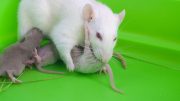
The cries of newborns can stimulate the release of oxytocin in mothers, aiding breast milk production, as demonstrated in a rodent study by NYU Grossman School of Medicine. The research underscores the significant role of this hormonal release in nursing and continuous maternal care, even when tired.
The cries of newborns can stimulate the release of oxytocin in mothers, aiding breast-milk production, as demonstrated in a rodent study by NYU Grossman School of Medicine. The research underscores the significant role of this hormonal release in nursing and continuous maternal care, even when tired.
Led by researchers at NYU Grossman School of Medicine, the study explored a centuries-old observation in humans and other mammals that when a baby begins a feeding session, its cries alone can prompt its mother to release breast milk. Studies dating back decades have shown that such calls for food, and not suckling itself, prompts the largest oxytocin surges. However, the mechanisms behind and purpose for this wail-to-milk pipeline have until now remained unclear.
Mechanisms Behind Oxytocin Release
According to the findings, which will be published today (September 20) in the journal Nature, when a mouse pup starts crying, sound information travels to an area of its mother’s brain called the posterior intralaminar nucleus of the thalamus (PIL). This sensory hub then sends signals to oxytocin-releasing brain cells (neurons) in another region called the hypothalamus, a control center for hormone activity.
Most of the time these hypothalamus neurons are “locked down” by proteins that act as gatekeepers to prevent false alarms and wasted milk. After 30 seconds of continuous crying, however, signals from the PIL were found to build up and overpower these inhibitory proteins, setting off oxytocin release.
“Our findings uncover how a crying infant primes its mother’s brain to ready her body for nursing,” said study co-lead author Habon Issa, a graduate student at NYU Langone Health. “Without such preparation, there can be a delay of several minutes between suckling and milk flow, potentially leading to a frustrated baby and stressed parent.”
Mother-Infant Bond and Oxytocin Release
The results also revealed that the oxytocin boost only occurs in mother mice and not in females who have never given birth. In addition, the mothers’ brain circuitry only responded to her pups’ cries and not to computer-generated tones designed to mimic natural wails.
According to Issa, the study offers the first description of how sensory experiences like hearing directly activate oxytocin neurons in mothers. She notes that the scientists used a relatively new kind of molecular sensor called iTango to measure actual oxytocin release from brain cells in real-time. Previously, she says, researchers could only take indirect measurements using proxies because the hormone degrades quickly given its small size.
For the study, the research team examined brain-cell activity in dozens of female mice. Then, in a form of “reverse engineering,” they traced how sound information travels through different areas of the brain to trigger milk flow.
Impact on Parental Behavior
Next, the team explored how this circuit affects parenting behavior. Normally, when pups stray or are removed from their nest, mothers will quickly retrieve them no matter how many times this occurs, says Issa. However, when the researchers chemically blocked the PIL from communicating with oxytocin neurons, the mice eventually tired and stopped fetching their young. Once the system was turned back on, the mothers pushed through their fatigue and continued caring for the infants.
“These results suggest that the crying-prompted brain circuit is not only important for nursing behavior, but also for maintaining a mother’s attention over time and encouraging effective care of her young even when she is exhausted,” said study senior author Robert Froemke, PhD. Froemke is the Skirball Foundation Professor of Genetics in the Department of Neuroscience and Physiology at NYU Langone.
Also a professor in the Department of Otolaryngology÷Head and Neck Surgery at NYU Langone, Froemke adds that learning how the oxytocin system works (and goes awry) in our own species may offer new ways to help human mothers who want to breastfeed but struggle to do so.
Froemke, a member of NYU Langone’s Neuroscience Institute, cautions that the researchers did not measure lactation itself, only the hormone release that prompts it.
Reference: “Neural circuitry for maternal oxytocin release induced by infant cries” by Silvana Valtcheva, Habon A. Issa, Chloe J. Bair-Marshall, Kathleen A. Martin, Kanghoon Jung, Yiyao Zhang, Hyung-Bae Kwon and Robert C. Froemke, 20 September 2023, Nature.
DOI: 10.1038/s41586-023-06540-4
Funding for the study was provided by National Institutes of Health grants T32MH019524, P01NS107616, and DP1MH119428. Further funding was provided by the Natural Sciences and Engineering Research Council of Canada PGS-D Fellowship and a Howard Hughes Medical Institute Faculty Scholarship.
In addition to Issa and Froemke, former NYU investigator Silvana Valtcheva, PhD, now at the University of Cologne in Germany, served as the study co-lead author. Other NYU Langone investigators involved in the study were Chloe Blair-Marshall, BS; Kathleen Martin, BS; and Yiyao Zhang, PhD. Additional study authors include Kanghoon Jung, PhD; and Hyung-Bae Kwon, PhD, at Johns Hopkins University in Baltimore, Md.









Be the first to comment on "Oxytocin Surge: Brain Circuit Discovered That Explains Why Infant Cries Prompt Milk Release"